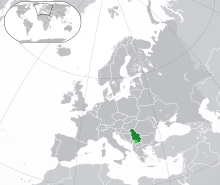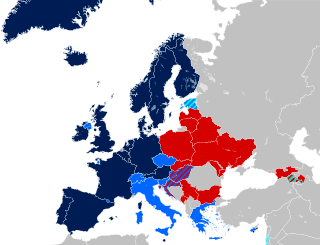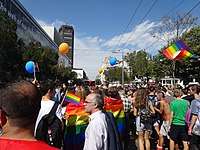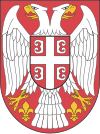LGBT rights in Serbia
| LGBT rights in Serbia | |
|---|---|
 Location of Serbia (green) – Kosovo (light green) on the European continent (dark grey) | |
| Same-sex sexual intercourse legal status |
Legal nationwide since 1994, age of consent equalized in 2006 |
| Gender identity/expression | Transgender people allowed to change gender only after surgery[1] |
| Military service | Lesbians, gays and bisexuals allowed to serve openly |
| Discrimination protections | Sexual orientation and gender identity protections (see below) |
| Family rights | |
| Recognition of relationships | No recognition of same-sex relationships. |
Restrictions: | Same-sex marriage constitutionally banned. |
| Adoption | – |
Lesbian, gay, bisexual, and transgender (LGBT) persons in Serbia may face legal challenges not experienced by non-LGBT residents. Both male and female same-sex sexual activity are legal in Serbia, and discrimination on the basis of sexual orientation is banned. Nevertheless, households headed by same-sex couples are not eligible for the same legal protections available to opposite-sex couples.
In May 2014, Amnesty International identified Serbia as one of a number of countries where there is a marked lack of will to tackle homophobia and transphobia, noting that public authorities had repeatedly banned pride marches on the basis of violent threats from homophobic groups.[2] A pride parade successfully took place in September 2014 in Belgrade.[3]
In 2016, the International Lesbian, Gay, Bisexual, Trans and Intersex Association (ILGA) ranked Serbia 28th in terms of LGBT rights out of 49 observed European countries.[4]
In June 2017, Ana Brnabić became the Prime Minister of Serbia, as the first woman and first openly gay person to hold the office, and the second female LGBT head of government overall (after Jóhanna Sigurðardóttir of Iceland). She was also the first Serbian Prime Minister to attend a pride parade.
Issues
Law regarding same-sex sexual activity
First Serbian Uprising (1804-1813)
Although religious laws existed prohibiting same-sex love and relationships, expressions were common in both Orthodox Christian and Islamic society.[5][6][7] The primary expression of same-sex love for Orthodox Christians were brotherhood unions known as "Pobratimstvo" (Adelphopoiesis).[8] The early nineteenth century saw a time of relative turmoil for Serbia, with sporadic periods of stability. In 1804, Serbia gained its autonomy from the Ottoman Empire following two uprisings. Karađorđe's Criminal Code (Карађорђев криминални законик) was subsequently promulgated by the Serbian Jurisprudential Council (Praviteljstvujušči sovjet serbski) sometime in late spring or early summer 1807, and remained in force until 7 October 1813, when the Ottoman Empire re-gained control of Serbia.[9] The Code penalised certain issues related to marital life and sexuality (such as forced marriage, rape, separation/divorce without the approval of a clerical court, and infanticide). It did not, however, mention same-sex sexual activity; and so homosexuality became effectively legal for a period of six years.
Principality of Serbia
In 1858, the Ottoman Empire, of which Serbia was nominally a vassal, legalized same-sex sexual intercourse.[10]
However, the progressive reforms introduced by Prince Alexander Karađorđević and Prince Mihailo were overturned when Miloš Obrenović returned to power. In the first post-Medieval Criminal Code of the Principality of Serbia, named "Kaznitelni zakon" (Law of Penalties), adopted in 1860, sexual intercourse "against the order of nature" between males became punishable by 6 months to 4 years imprisonment. Like in many other countries' legal documents of the time, lesbian sexuality was ignored and not mentioned.[11][12]
Yugoslavia
In 1918, Serbia became a part of the Kingdom of Yugoslavia. At first, the new state effectively inherited the different laws that applied to the different territories that joined together (often contradictory). Eventually, the new Yugoslav Criminal Code of 1929 banned "lewdness against the order of nature" (anal intercourse) between human beings (heterosexual and homosexual). The Socialist Federal Republic of Yugoslavia later restricted the offense in 1959 to only apply to homosexual anal intercourse; but with the maximum sentence reduced from 2 to 1 year imprisonment.[10]
Socialist Autonomous Province of Vojvodina
In 1977, same-sex sexual intercourse was legalized in the Socialist Autonomous Province of Vojvodina, while male same-sex sexual intercourse remained illegal in the rest of the Socialist Republic of Serbia (including the Socialist Autonomous Province of Kosovo). In 1990, Vojvodina was reincorporated into the legal system of Serbia, and male homosexuality once again become a criminal offense.[13][14]
Yugoslavia/Serbia and Montenegro
In 1994, male homosexual sexual intercourse was officially decriminalised in the Republic of Serbia, a part of the Federal Republic of Yugoslavia. The age of consent was set at 18 years for anal intercourse between males and 14 for other sexual practices. An equal age of consent of 14 was later introduced on 1 January 2006, regardless of sexual orientation or gender.[14]
Recognition of same-sex relationships

¹ May include recent laws or court decisions which have created legal recognition of same-sex relationships, but which have not entered into effect yet.
While same-sex couples have never been recognized by law, the new Serbian Constitution adopted in November 2006, explicitly defines marriage as being between a man and a woman (Article 62).[15] However, other forms of recognition, such as civil unions or domestic partnerships, are not explicitly mentioned nor prohibited.
Discrimination protections
Until 2002, Serbia had no special protection specifically aimed at LGBT rights.
In 2002, the National Assembly approved the Broadcasting Law which prohibits Serbian broadcasting agencies from spreading information encouraging discrimination, hate and violence based on sexual orientation (among other categories).[16]
In 2005, through a change in the Labor Law, discrimination based on sexual orientation in employment was banned.
In 2005, Parliament approved the Law on Higher Education, which guarantees equal rights regardless of sexual orientation in those institutions (among other categories).
On 26 March 2009, Parliament approved a unified anti-discrimination law which prohibits, among other things, discrimination on the basis of sexual orientation and transgender status in all areas.[17]
On 5 July 2011, the Parliament approved a youth law, prohibiting discrimination on the ground of sexual orientation. The law regulates measures and activities undertaken by local governments at improving the social status of youth and creating conditions for addressing their needs and interests.[18]
Gender identity and expression
On 28 July 2011, the Parliament approved a change in the Health Insurance Law, based on which sex change surgeries became partially covered by the statewide basic medical insurance plan, beginning in 2012.[19]
In 2012, The New York Times proclaimed Belgrade as a hub for sex reassignment surgery, as prices for such procedures are far lower than in neighbouring and Western countries.[1]
Transgender people in Serbia are allowed to change their legal name and gender but only after having undergone sex reassignment surgery. Government-financed health insurance covers up to 65% of the surgery, while the remainder is financed by the patient. However, Serbian law prevents transgender people from altering their legal gender and name without undergoing surgery. According to Jovanka Todorovic, a program coordinator at Gayten-LGBT, about 80% of Serbian transgender people are not willing to go through surgery. Instead, some choose to have hormone replacement therapy, which is not financed by health insurance. Transgender activists are currently lobbying for a Gender Identity Law, which would make it easier for transgender people to change their gender.[1]
Laws against anti-LGBT speech
Since 2003, there has been legislation (part of the Information Law) specifically in place to counter verbal discrimination based on sexual orientation within the media. The same prohibition formed part of the Radio Emitters Law adopted in 2002; however, it was never effectively observed, with the Radio Emitters Agency (an independent government agency) having failed to take any action against offenders. More widely, the Anti-Discrimination Law of 2009 prohibits hate speech on the basis of sexual orientation across wider Serbia society.[20]
Hate crime laws
On 24 December 2012, the Serbian Parliament approved changes to the Penal Code to introduce the concept of a "hate crime", including on the basis of sexual orientation and gender identity.[21]
Military service
In 2010, the Serbian Army agreed that gay and bisexual men and women may openly serve in the professional army, but that news was not broadcast widely across media. Nevertheless, Serbian LGBT rights activists transmitted the news within their communities, encouraging people to apply.
LGBT rights movement
Many LGBT organizations have been founded in Serbia, especially in Belgrade and Novi Sad, though also in Niš, Kragujevac, Subotica, Šabac and Zrenjanin.
Organizations, sorted by founding date, descending
- 1990-1995: Arkadija, Belgrade
- 1995: Labris, Belgrade; previously part of Arkadija
- 1999-2004: New Age - Rainbow, Novi Sad
- 2000: Gayten LGBT, Belgrade; previously part of Arkadija
- 2000-2003: Deve, Belgrade; previously part of Arkadija and Labris
- 2000-2003: Queer Studies Programme, Belgrade
- 2000: Queeria Center, Belgrade
- 2001: LGBT Vojvodina, Novi Sad
- 2001: Safe Pulse of Youth, Belgrade
- 2002-2009: Lambda, Niš and Kragujevac
- 2003-2004: Pride, Belgrade
- 2004: Taboo, Zrenjanin and Kragujevac
- 2004: Novi Sad Lesbian Organization, Novi Sad
- 2005: Queer Belgrade, Belgrade; previously part of Pride
- 2005: Gay Straight Alliance, Belgrade; previously part of Pride
- 2006: Duga, Šabac
- 2008-2011: LGBT Left, Subotica
- 2009: Gay Lesbian Info Center, Belgrade; previously part of Queeria Center
- 2010: Support Group for Young Gay Men, Novi Sad
- 2011: Belgrade Pride, Belgrade
- 2013: GOOSI, a gay organization for people with disabilities, Belgrade
- 2013: LGBT Novi Sad, Novi Sad
Online communities and news portals, sorted by founding date, descending
- 1998: Gay-Serbia.com
- 2001: Adriatic LGBT Activism, formerly known as Yugoslavian LGBT Activism
- 2001: GayEcho, formerly known as Queeria
- 2008: GayRomeo, version in Serbian
- 2011: Optimist LGBT magazine
- 2012: Szerbiai Magyar LMBT Csoport, the Hungarian LGBT community in Serbia
- 2012: Gay Serbia Guide
Social conditions

Gays and lesbians continue to face discrimination and harassment in Serbia. The majority of Serbian people retain strong attitudes against homosexuality. There have been numerous instances of violent gay-bashing, the most extreme during the first Belgrade Gay Pride in 2001.
Several pride events have had to be cancelled. Pride Day celebrations in Belgrade in 2004 (initiated by activists around GSA), and another in Novi Sad initiated by LGBT Vojvodina in 2007 were cancelled either because of failed cooperation between activists, or an inability to provide adequate safety against violence due to resource constraints. The 2009 Belgrade Pride was also cancelled for similar reasons, as police could not guarantee the safety of participants.[22] The Second Belgrade Pride parade went ahead on 10 October 2010, with the participation of around a thousand people. However, it was met with violent reaction and riots attended by 6,000 anti-gay protesters and extreme nationalist group members.
Official medical textbooks that classify homosexuality under "sexual deviations and disorders" were in circulation and widely used. After several requests to do so, the Serbian Medical Society finally stated that same-sex orientation is not a disease in an official letter to Labris in 2008. Homosexuality has been removed from the official list of diseases since 1997, when Serbia started applying ICD-10.[23][24]
The protection of LGBT people in Serbia is further complicated by the existence of various nationalist and neo-nazi associations like 'Obraz', '1389' and 'Stormfront', which are supported by some right-wing political parties. These groups have, on several occasions, made their threats to LGBT people publicly known, though the media and the police are increasingly reacting to deter such threats publicly.
The development of LGBT rights and culture in Serbia is supported by LGBT sites such as GayEcho and Gay-Serbia and the oldest Adriatic LGBT Activism mailing list in the region.
In November 2015, former President Boris Tadić expressed his support for same-sex marriage and adoption.[25]
In August 2016, Ana Brnabić was appointed Minister of Public Administration and Local State Governments, becoming the first openly lesbian minister in Serbia. In June 2017, Serbian President Aleksandar Vučić appointed Brnabić to be the Prime Minister. She was sworn in on 29 June 2017. Her appointment received criticism and opposition from both left-wing and right-wing groups. Left-wing groups accused Brnabić of being a puppet to the President and that her sexual orientation would serve as a cover-up for human rights abuses. Right-groups opposed her nomination because of her sexual orientation.[26]
In September 2017, Prime Minister Brnabić took part in the pride parade in Belgrade.[27] At the event, Mrs. Brnabić said:
The government is here for all citizens and will secure the respect of rights for all citizens
Public opinion
According to the Commissioner for the Protection of Equality, research carried out in 2012 showed that 48% of Serbs believed that homosexuality is an illness.[28]
According to a 2017 poll carried out by ILGA, 59% of Serbians agreed that gay, lesbian and bisexual people should enjoy the same rights as straight people, while 24% disagreed. Additionally, 64% agreed that they should be protected from workplace discrimination. 21% of Serbians, however, said that people who are in same-sex relationships should be charged as criminals, while 55% disagreed. As for transgender people, 63% agreed that they should have the same rights, 65% believed they should be protected from employment discrimination and 51% believed they should be allowed to change their legal gender.[29] Additionally, a majority of Serbians would accept an LGBT neighbour.
Summary table
| Same-sex sexual activity legal | |
| Equal age of consent (14) | |
| Anti-discrimination laws in employment | |
| Anti-discrimination laws in the provision of goods and services | |
| Anti-discrimination laws in the media | |
| Anti-discrimination laws in all other areas | |
| Hate crime laws include sexual orientation and gender identity | |
| Same-sex marriages | |
| Recognition of adoption for single people regardless of sexual orientation | |
| Recognition of same-sex couples | |
| Stepchild adoption by same-sex couples | |
| Joint adoption by same-sex couples | |
| Gays, lesbians and bisexuals allowed to serve in the military | |
| Right to change legal gender | |
| Access to IVF for lesbian couples | |
| Automatic parenthood for both spouses after birth | |
| Homosexuality declassified as an illness | |
| Transsexuality declassified as an illness | |
| Conversion therapy banned on minors | |
| Commercial surrogacy for gays | |
| MSMs allowed to donate blood |
See also
Further reading
- Mikuš, Marek (November 2011). ""State Pride": Politics of LGBT rights and democratisation in "European Serbia"". East European Politics and Societies. Sage. 25 (4): 834–851. doi:10.1177/0888325411426886.
- Rhodes-Kubiak, Robert (2015). Activist Citizenship and the LGBT Movement in Serbia: Belonging, Critical Engagement, and Transformation
- Bogetić, Ksenija (2013). "Normal straight gays: Lexical collocations and ideologies of masculinity in personal ads of Serbian gay teenagers". Gender and Language. Equinox. 7 (3): 333–367. doi:10.1558/genl.v7i3.333.
References
- 1 2 3 4 Serbia’s Embattled Trans People Hope for Brighter Future
- ↑ "Homophobia still tolerated by governments around the world". Amnesty International. 16 May 2014. Retrieved 23 December 2014.
- ↑ "USPEH: Beograd Prajd 2014 – nova strana istorije!". Parada ponosa Beograd. Retrieved 23 December 2014.
- ↑ "Country Ranking - Rainbow Europe". rainbow-europe.org. Retrieved 25 October 2017.
- ↑ Pre gotovo 200 godina Srbija je iz budžeta plaćala mlade gejeve da budu ljubavnici Turcima
- ↑ Peter Drucker, “Byron and Ottoman Love: Orientalism, Europeanization and Same-Sex Sexualities in the early nineteenth-century Levant,” Journal of European Studies 42 (2012) 145
- ↑ Dror Ze’evi, “Hiding Sexuality: The Disappearance of Sexual Discourse in the Late Ottoman Middle East,” The International Journal of Social and Cultural Practice 49 (2005) 43
- ↑ Nik Jovčić-Sas, 2018, "The Tradition of Homophobia: Responses to Same-Sex Relationships in Serbian Orthodoxy from the Nineteenth century to the Present day," In: Chapman, Mark, Janes, Dominic. "New Approaches in History and Theology to Same-Sex Love and Desire" London: Palgrave Macmillan, 55-77p
- ↑ The full text was rediscovered in the State Archives in 1903, upon accession of Karađorđe's grandson Peter I of Serbia to the throne.
- 1 2 "CROATIA: NEW PENAL CODE". Archived from the original on 14 April 2016. Retrieved 25 October 2017.
- ↑ V. Para # 206, p. 82 of the "Kaznitelni zakon 1860" in Slavo-Serbian orthography
- ↑ Mihailo will go on with liberalising and modernising Serbia during his own second reign, q.v. in Mihailo Obrenović III, Prince of Serbia
- ↑ "LGBTQ Timeline" (PDF). Archived from the original (PDF) on 4 March 2016. Retrieved 25 October 2017.
- 1 2 Tapon, Francis (8 December 2011). "The Hidden Europe: What Eastern Europeans Can Teach Us". SonicTrek, Inc. Retrieved 25 October 2017 – via Google Books.
- ↑ Serbian Constitution Archived 2010-11-27 at the Wayback Machine.
- ↑ "Serbia: Law on Broadcasting (Official Gazette of the Republic of Serbia No. 42/02)". www.wipo.int. Retrieved 25 October 2017.
- ↑ Anonymous (29 April 2009). "Serbia: Anti-Discrimination Law is Adopted". Retrieved 25 October 2017.
- ↑ LAW on YOUTH
- ↑ "Serbia - Act of 28 July 2011 to amend and supplement the Act on Health Insurance". ilo.org. Retrieved 25 October 2017.
- ↑ European Commission, Serbia 2009 Progress Report, p. 14
- ↑ (in Serbian) Usvojene izmene Krivičnog zakonika
- ↑ "Pride Parade won't be held". B92. 19 September 2009. Retrieved 19 September 2009.
- 1 2 Međunarodna klasifikacija bolesti - online
- 1 2 Institut za javno zdravlje Srbije "Dr Milan Jovanović Batut" - MKB-10
- ↑ "Korigujem stav o gej parovima".
- ↑ Serbia Gets Its First Female, and First Openly Gay, Premier The New York Times
- ↑ "Serbia's first openly-gay Prime Minister Ana Brnabic joins hundreds of marchers at LGBT pride event". The Independent. 17 September 2017.
- ↑ "SERBIA - LGBTI Equal Rights Association for Western Balkans and Turkey". www.lgbti-era.org. Retrieved 25 October 2017.
- ↑ ILGA-RIWI Global Attitudes Survey ILGA, October 2017
| Wikimedia Commons has media related to LGBT in Serbia. |
